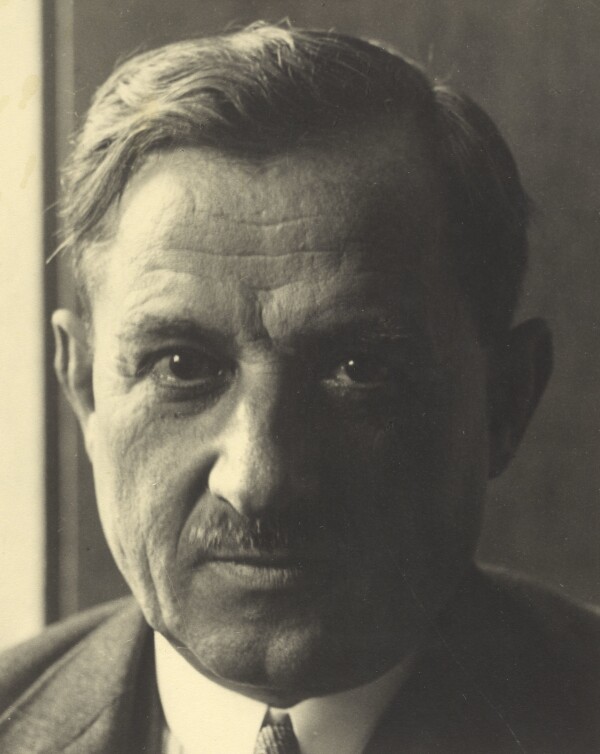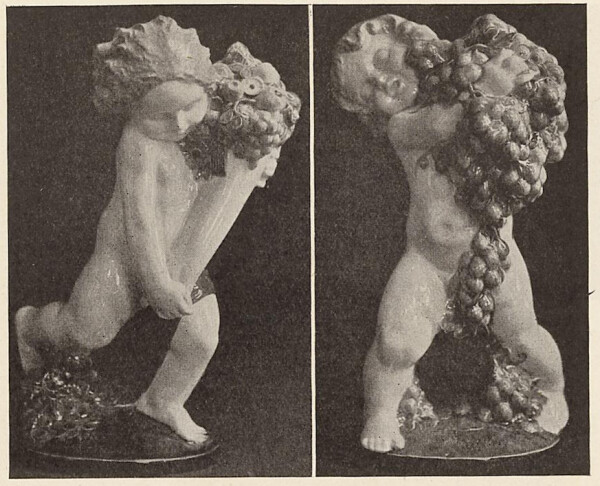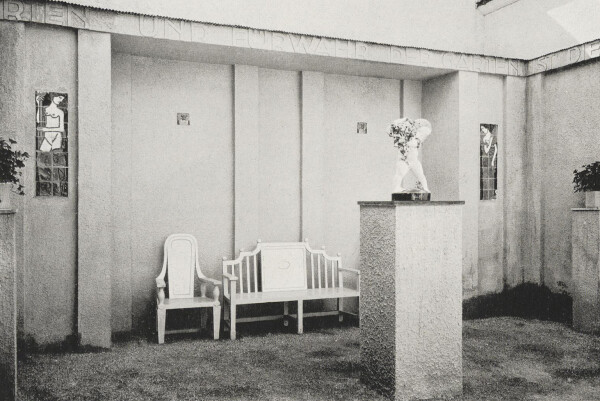Michael Powolny

Michael Powolny photographed by Ludwig Schab, Austrian National Library, Vienna
© Picture Archives and Graphics Department, Austrian National Library

Michael Powolny: Two putti for the Wiener Keramik-Werkstätte, in: The Studio. Yearbook of decorative art (1909).
© Heidelberg University Library

Works by Michael Powolny and Bertold Löffler in the courtyard of the Vienna Art Show 1908, in: Moderne Bauformen. Monatshefte für Architektur und Raumkunst, 7. Jg. (1908).
© Heidelberg University Library
In 1905, the independent sculptor and ceramist Michael Powolny founded the company Wiener Keramik together with Bertold Löffler. Its products were also marketed by the Wiener Werkstätte. He collaborated, among other projects, on the decoration of the Villa Skywa-Primavesi, the Kabarett Fledermaus, and the Stoclet Palace in Brussels.
Michael Powolny was born in Judenburg in 1871. At a young age, he completed an apprenticeship as a furnace setter under his father and gained his first work experience as an assistant in Steyr. From 1891 on he attended the Imperial-Royal Technical School for the Clay Industry in Znaim (now Znojmo, Czech Republic) for three years and then studied at the School of Arts and Crafts in Vienna, where the sculptors Arthur Strasser and Franz Metzner were among his teachers. After graduation he also assisted at the school for several years at the Figure Modeling Department.
Foundation of an Association and a Manufacture
In 1903, together with other young applied artists, all of them graduates of the School of Arts and Crafts or former students of the professors Josef Hoffmann or Koloman Moser, Powolny founded a new association of artists called Wiener Kunst im Hause, which took part for the first time in the “XV. Ausstellung der Vereinigung bildender Künstler Österreichs Secession” [“15th Exhibition of the Association of Austrian Artists Secession”]. A few years later, together with the designer Bertold Löffler, he opened the Wiener Keramik factory, which was to be known primarily for its putti and crinoline figurines. From 1907 on, the products of Wiener Keramik were distributed by the Wiener Werkstätte, for which Powolny also worked. During this period, Powolny designed ceramic works – mostly in characteristic black and white – for the Kabarett Fledermaus, the Stoclet Palace in Brussels, and the Villa Skywa-Primavesi in Vienna in close cooperation with the Wiener Werkstätte and Josef Hoffmann. Later on, the designer, who exhibited at the “Kunstschau Wien” in 1908 and the “Esposizione Internationale di Roma” [International Art Exhibition of Rome”] in 1911, among others, also received commissions from the Lobmeyr company, the Viennese porcelain manufacturers Augarten and Josef Böck, and the City of Vienna.
Further Milestones
Powolny’s manufactory finally merged with Gmundner Keramik in 1912, which still exists today. That same year, Powolny took on a teaching position at the Vienna School of Arts and Crafts, where he first taught ceramics and then, from the 1920s onward, also glass finishing and sculpture. After World War II, the designer again devoted himself increasingly to small ceramic objects and also designed Schilling and Groschen coins for the Republic of Austria. In 1951, Michael Powolny was awarded the Gold Medal of Honor of the Federal Capital of Vienna for his artistic merits. He died in Vienna three years later.
Literature and sources
- Die Zeit, 30.11.1903, S. 3.
- Felix Czeike (Hg.): Historisches Lexikon Wien, Band 4, Vienna 1995, S. 588.
- Felix Czeike (Hg.): Historisches Lexikon Wien, Band 5, Vienna 1997, S. 634.
- Hans Vollmer (Hg.): Allgemeines Lexikon der Bildenden Künstler von der Antike bis zur Gegenwart. Begründet von Ulrich Thieme und Felix Becker, Band XXVII, Leipzig 1933, S. 330-331.
- Walter de Gruyter (Hg.): Allgemeines Künstler-Lexikon. Die bildenden Künstler aller Zeiten und Völker, Band XCVI, Berlin 2017, S. 446.
- Dekorative Kunst. Illustrierte Zeitschrift für angewandte Kunst, Band 25 (1916), S. 132-138.
- Leopold Wolfgang Rochowanski: Wiener Keramik, Vienna 1923.
- Thomas Artl, Arthur Weilinger: Wiener Keramik 1906-1912. Bertold Löffler – Michael Powolny. Werkverzeichnis, Vienna 2018.
- Leopold Wolfgang Rochowanski: Neue Arbeiten von Michael Powolny, in: Deutsche Kunst und Dekoration, Band 62 (1928/29), S. 256-257.

